There is nothing like cracking a freshly laid egg in the morning and making yourself a delicious breakfast. This is one of the privileges you can enjoy when you have an Amberlink hen as part of your backyard flock.
Once upon a time, these chickens were quite popular in the United States, but they have become less common in the years since. Luckily, these chickens’ reputation as champion egg layers is helping them make a comeback.
This chicken’s appearance may not win it any awards, but it is still a beautiful addition to any flock. Their size makes them suitable for almost any operation and they lay some of the most beautiful eggs you’ll come across.
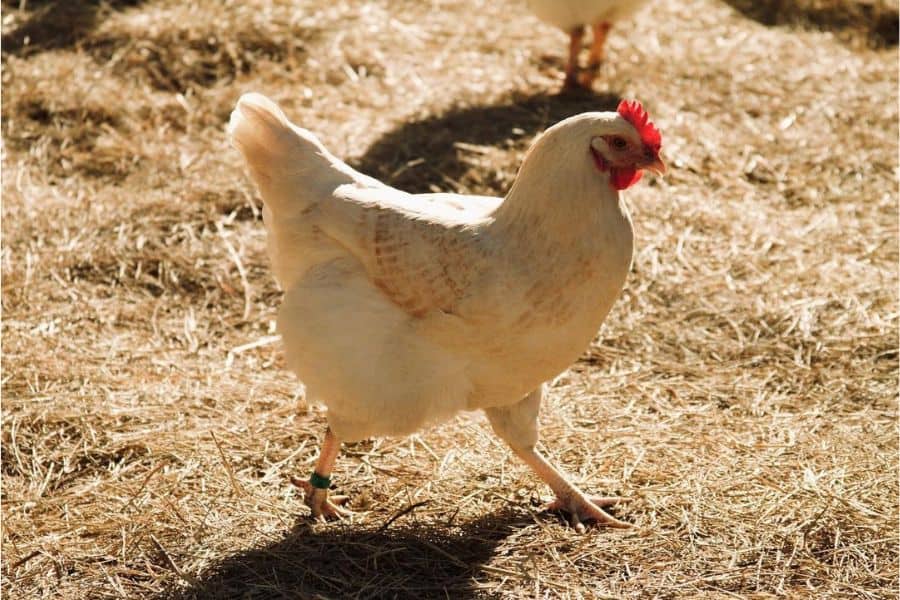
On the other hand, the productivity of Amberlink Chickens and their genetics can work against them resulting in a shorter lifespan compared to some other backyard chickens.
The Amberlink chicken can be a great addition to your flock if you have been missing a reliable layer. We take a look at this bird’s origins, productivity, and what it takes to care for them.
Amberlink Chickens Quick Facts
| Names | Amberlink, Dekalb Amberlink, Amber Sex Link Chickens |
| Origins | USA |
| Primary Purpose | Egg Production |
| Egg Production | High |
| Climate | Cold Hardy and Heat Tolerant |
| Personality | Mild-Mannered |
| Weight | Roosters: 6 lbs.
Hens: 4 lbs. |
| Interesting Facts | Likes to forage which isn’t common in hybrid chicken. |
A Brief History of Amberlink Chickens
Origins
Dekalb Amberlinks, commonly referred to as Amberlink chickens, were brought to us by Hendrix ISA. The same folks who gave us the famous ISA Brown chickens.
Hendrix ISA is a company that specializes in animal breeding and is known for producing highly productive layers.
Not enough information is available regarding the origins of these hybrid chickens. Some sources claim they are the result of crossing Rhode Island Reds with White Plymouth Rocks while others say it is Rhode Island Reds with Light Sussexes.
Peak and Decline
The popularity of Amberlink chickens peaked in the 1970s when they were easy to come by in the United States. Unfortunately, this peak would not last as they would be quickly overtaken by other hybrids that were better suited for industrial egg production.
Comeback
Interest in layers and other chickens that can thrive in a cruelty-free environment has grown in recent years. This is because more people are learning about the negative effects current large-scale egg production systems have had on the welfare of chickens.
The Dekalb Amberlink is better for an egg production system that does not involve the use of cages or batteries. They forage well compared to other well-known hybrids and retain their feathers better.
Due to these qualities, hobbyists and other individuals looking to raise their own poultry in a humane manner favor Amberlink chickens. This has caused a resurgence in the popularity of this hybrid.
Amberlink Chicken Appearance
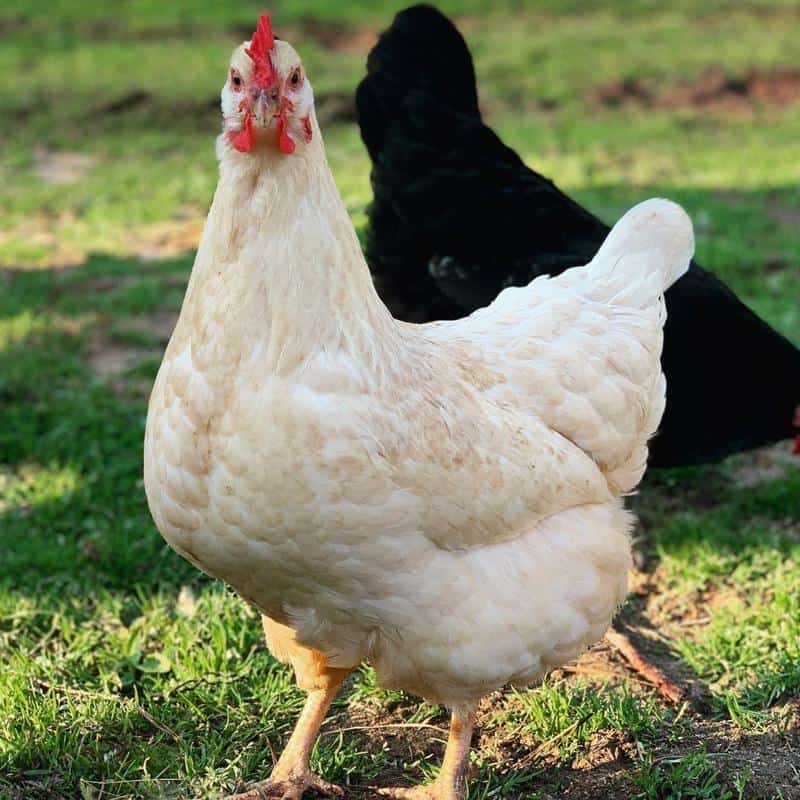
Even though we don’t all admit it, aesthetics dictates the kinds of chickens we choose.
A large-scale producer may be all about output. However, when you have chicken running around in your backyard, perhaps eating out of your hand from time to time, you will regularly notice how they look.
The good thing about Amberlink chickens is while they don’t have the beautiful feather patterns or features of a show bird, they’re still beautiful birds to look at.
Plumage
The feathers of Amberlink hens are primarily white. White is a common color in chickens so it is unlikely these chickens will stand out in a bad way.
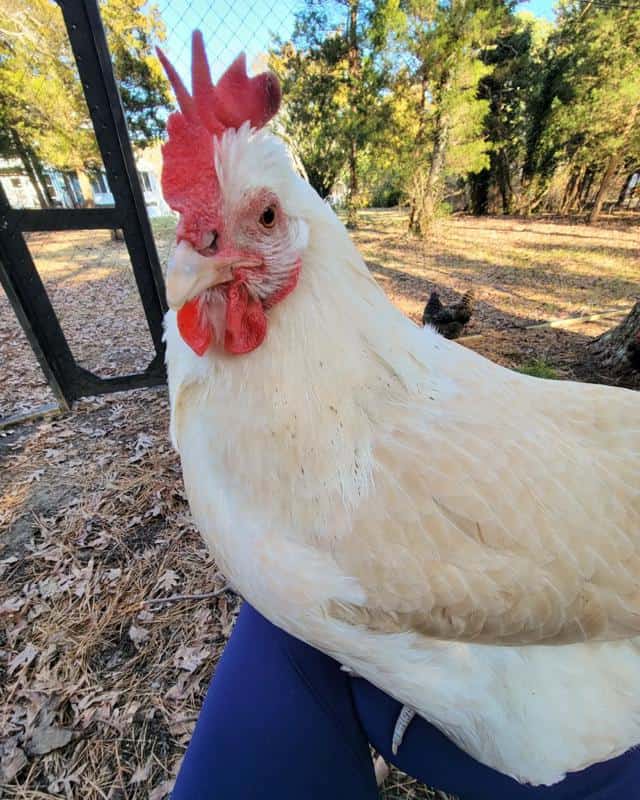
The hens will also have light brown feathers in some parts of their body. The brown color in the roosters may be a little richer and show up on the head and neck as well.
Comb and Wattle
Amberlink chickens have a single comb. The comb and the wattle are unmistakably red and stand out against the chicken’s lighter plumage.
Size
Dekalb Amberlink chickens are small compared to other chickens at maturity. The roosters will usually reach a maximum of 6 pounds while the hens will only be 4 pounds.
This low weight is not uncommon for a hybrid chicken that is intended for egg production.
Amberlink Chicken Purpose
Eggs
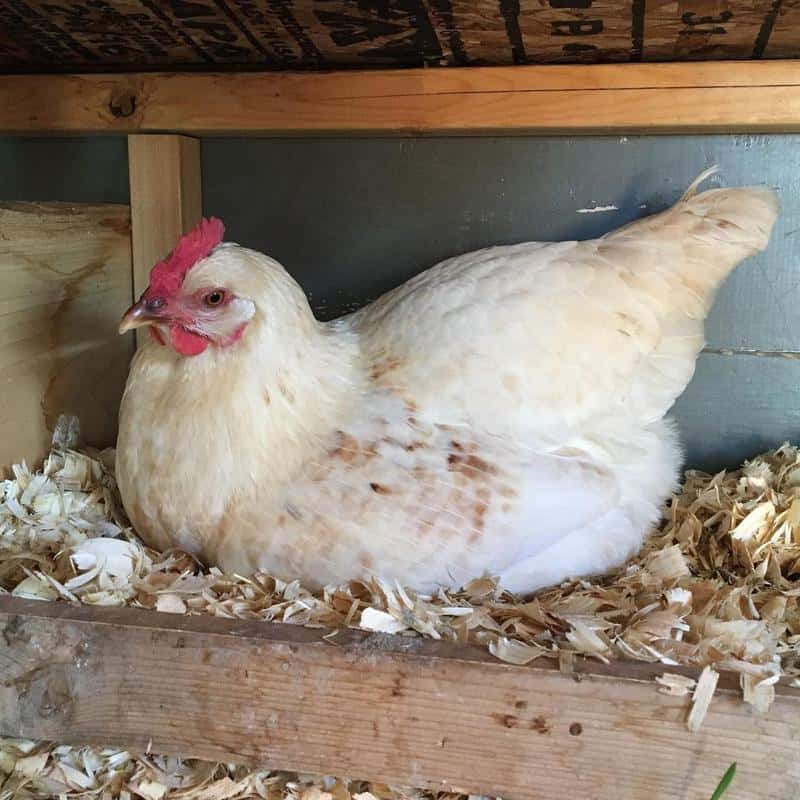
As a product of ISA Hendrix, the purpose of Amberlink chickens is clear from the start. That is to be the top egg layer in your backyard flock.
Amberlink chickens are prolific layers, and it is said that they lay eggs consistently even during winter. This is a normal concern among many farmers since egg-laying in many breeds will start to taper when the weather starts to get colder.
Amberlink chickens are particularly prolific during their first two egg-laying seasons. After the second season of egg production, the number of eggs produced will decline by up to 20% each year.
Amberlink chickens can provide around 270 eggs in a single year, but some farmers claim to get as many as 300 eggs in the same period.
The color of the eggs from Amberlink chickens will be a medium or dark brown with strong shells.
Other Purposes
Unfortunately, Amberlink chickens were never intended to serve any purpose other than to be egg-laying champions.
Neither hens nor roosters have considerable weight at maturity and their colors and feather patterns are unlikely to catch the eye in an exhibition.
Rearing Amberlink Chickens
Amberlink chickens have become popular among small-scale farmers. They can be raised in an environment that allows them to roam and forage outside for some periods during the day.
To get the best out of your Amberlink chickens, it is important to keep them in a comfortable environment. They should also be fed a diet that suits the unique demands of their bodies.
Housing and Environment
These chickens are best raised without cages. This means providing them with a well-ventilated coop that offers shade and shelter when they need it, but also some open space where they can walk around during the day.
Depending on how many hens you’ll get, ensure that you have enough nesting boxes to give them a comfortable space in which to lay their eggs. Without enough nesting boxes, you could end up with broken eggs or eggs in an obscure corner of your barn.
Amberlink chickens were developed in the United States so the colder weather in the north was considered during their development. As a result, these chickens don’t suffer the same stress levels as other chickens during cold winters.
Diet
Egg laying puts a different kind of demand on the bodies of chickens. These demands are much higher on highly productive breeds like Amberlinks which can produce as many as 300 eggs in one year.
Although these chickens are good at foraging, there is no guarantee that they’ll be able to get all their nutritional needs from this. The best approach is to provide your chickens with high-quality feed that you can either prepare yourself or buy.
The demands of egg-laying are so significant that they are said to contribute to the shortened lifespan of these chickens. Egg production will use up much of the calcium that is stored in such chickens’ bones.
A nutrient-poor diet can result in a disappointing output from your Amberlinks. Some could also die early due to nutrient deficiencies.
Temperament
Even when confined, Amberlinks are not known to get as aggressive as other hybrid chickens. This makes it easy to raise them with other breeds and they also interact well with humans.
Lifespan
The lifespan of Amberlink chickens is not unusual among hybrids but some farmers may find it a little short for a backyard chicken.
These hybrids are unlikely to live past their fourth year. This compares poorly to regular backyard breeds which can live up to 10 years, and some live longer than that.
Unfortunately, it is the feature that makes Amberlink chickens so appealing to farmers that is also cited as the cause of its short lifespan.
Laying eggs on a regular basis means the chickens’ reproductive systems don’t get to rest. The production of eggs also uses up nutrients in the chickens’ bodies, notably calcium.
All these factors cause health issues that lead to their early deaths. If you’re planning on having an Amberlink chicken as your regular supplier of eggs, consider the fact that you will have to replace it after a few years.
Brooding and Breeding in Amberlink Chickens
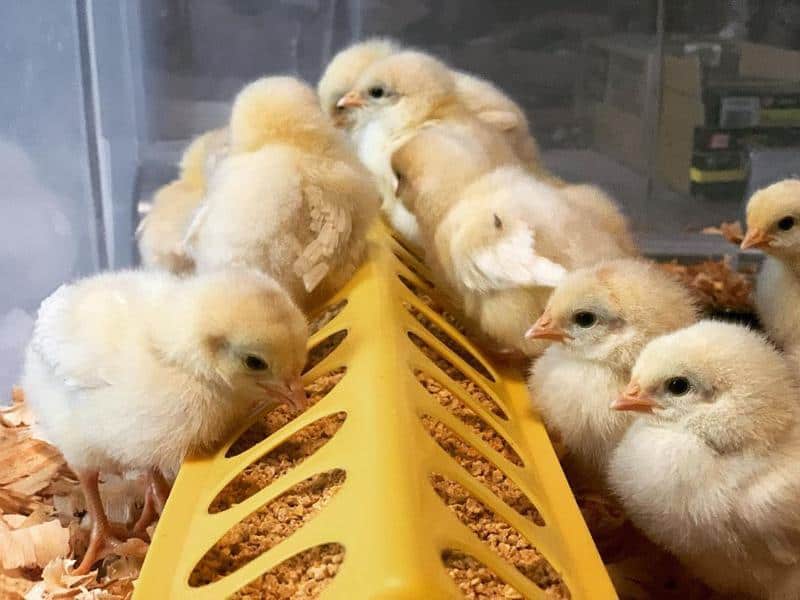
Brooding in Amberlink Hens
Amberlink chickens may be egg-laying champions but are unlikely to win any awards when it comes to being mothers. This is not unexpected because these hybrids were only intended to lay eggs, not to sit on eggs.
It is not uncommon for hybrid hens not to have the instinct that makes other hens broody. Additionally, the fact that these chickens are hybrids means you may not want their offspring to begin with.
Breeding Amberlink Chicks
Hybrids are the offspring of two pure breeds of chickens, and they are loved because they can have exceptional meat or egg production capacity. However, these chickens don’t breed true and the offspring of two hybrids will not have the same qualities as its parents.
The breeding process that gives us Amberlink chickens is not easy to replicate. Getting a hybrid with a quality such as a high rate of egg production may require breeding for several generations.
The breeding process is controlled and only the developers of such commercial hybrids know exactly what is involved. Therefore, if you were hoping to breed your own Amberlink chicks, you’d be facing a significant challenge.
Taking Care of Amberlink Chicks
One of the best ways to raise Amberlink chickens is from chicks. Although availability will vary, you can find a suitable seller on the internet.
Be sure to get your chicks from a reputable seller so you know you’re getting quality chicks.
Before your chicks arrive, you should prepare the space in which they’ll be kept because Amberlink chicks need a space that is clean and warm.
If you’ve kept chickens or other poultry in that space before, you should disinfect it to avoid transmitting diseases to the chicks. You should also ensure the space can’t be accessed by cats, dogs, or rodents.
It’s a good idea to get a heat lamp especially if it’s a little cold outside and the lamp should be hanging one and a half feet from the ground. The chicks should have suitable bedding and a constant supply of water.
An easy way to know if your chicks are comfortable is to simply observe them.
For instance, if the chicks are too cold, they’ll start huddling together. They will also be louder than usual.
If they’re all standing towards the edge of the enclosure, it could be because the lamp is too warm.
Avoid using open pans, dishes, and other similar containers for watering your chicks as these can cause drowning or get your chicks wet and cold.
Read More:
Should You Add an Amberlink to Your Flock?
Many people have fallen in love with the idea of farming their own chickens, but many are also conscious of the fact that commercial farming practices can be cruel.
Amberlink chickens provide small-scale farmers with the opportunity to have a high-output layer in a cruelty-free environment. Amberlink chickens were developed by the ISA Hendrix company but fell out of favor at some point.
These chickens are making a comeback as more farmers are eager to gain from their high egg production rate. Amberlink chickens are small which means that egg-laying is what they’re primarily good for.
Taking care of grown Amberlink hens isn’t too different from taking care of any other backyard chicken. The main difference is that the high rate of production means you’ll have to keep these hens on a good diet to keep them healthy even as they forage.
The short life span of these chickens means you’ll need to replace them more frequently and breeding isn’t really an option. Luckily, with a little bit of effort, you can get some Amberlink chicks, and taking care of these isn’t too challenging.
If you’re all about getting a steady supply of brown eggs and can provide the quality of feed that these birds demand, Amberlink chickens are an excellent option to have.
